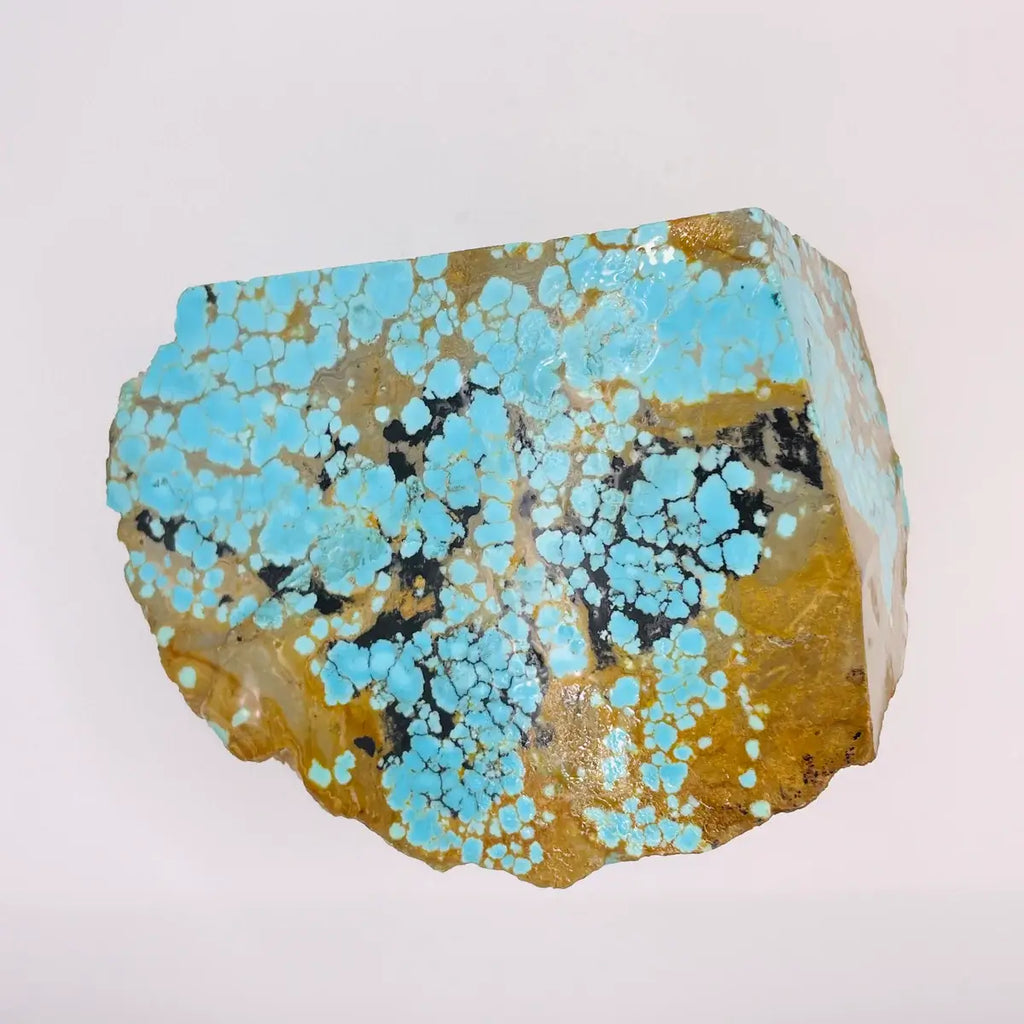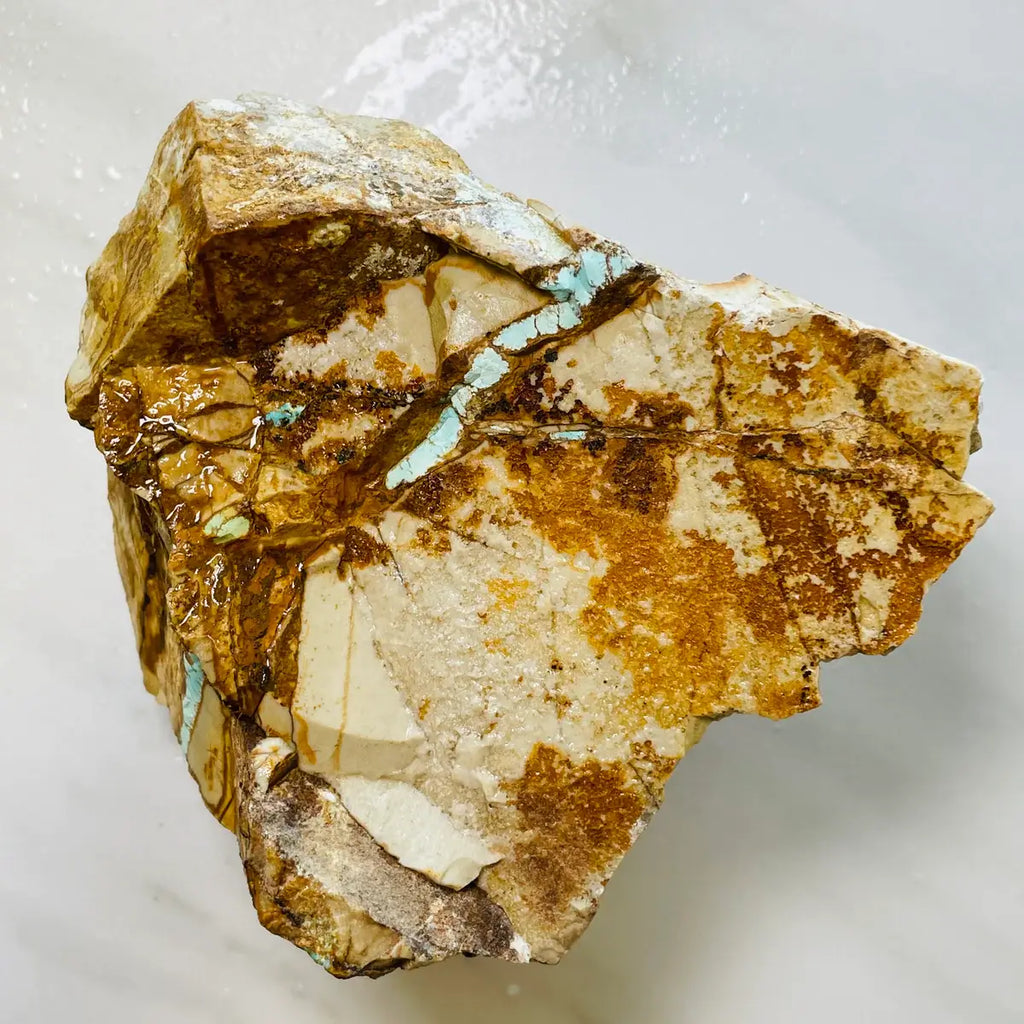Unlocking the Beauty: Essential Dos and Don'ts When Handling Rough Turquoise
The captivating beauty of rough turquoise, a gemstone steeped in history and charm, is truly unparalleled. Discover the dos and don'ts of working with this exquisite stone to preserve its natural beauty and ensure its longevity.
In this educational guide, we'll delve into essential practices for handling, cleaning, and caring for rough turquoise. From one turquoise lover to another, let's go on a journey to unlock some useful tips and tricks when it comes to working with this mesmerizing gemstone.
The Enchanting World of Rough Turquoise
Rough turquoise showcases a stunning array of colors, ranging from vibrant blues to serene greens, often interlaced with intricate veining and captivating matrix patterns. This gemstone is a hydrous phosphate of aluminum and copper and is formed in arid regions with copper-rich water percolating through rock formations.

Turquoise is treasured worldwide and has been used for centuries in jewelry and decorative objects.
Handle with Care: Protecting Your Precious Turquoise
Rough turquoise is relatively soft, rating between 5 and 6 on the Mohs scale of hardness. It requires careful handling to prevent scratches, chips, and cracks. Make sure to avoid exposing rough turquoise to sharp objects or rough surfaces, as they can easily damage the gemstone.
When it comes to handling rough turquoise, it is advisable to wear gloves to prevent oil transfer; use clean, lint-free cloths to protect the stone's surface.
Cleaning Rough Turquoise: Secrets to Restoring Its Radiance
Cleaning rough turquoise requires a gentle approach to preserve its delicate beauty. To clean the gemstone, use lukewarm water and a mild, phosphate-free soap. Gently scrub the stone with a soft brush or cloth, ensuring you reach all the crevices while being careful not to apply excessive pressure.
It's important to note this: avoid using harsh chemicals, such as ammonia, bleach, or acidic cleaners, as they can damage the stone and alter its color.
Stabilization and Treatment: Unveiling the Truth
Stabilization is a common practice in the turquoise world to enhance the stone's durability. How it works is it involves injecting a stabilizing agent, such as epoxy resin, into the porous turquoise to harden it. While stabilized turquoise is generally more resistant to scratches and changes in color, it is best for sellers to disclose any stabilization treatments.

Shielding Turquoise from Harsh Elements: Dos and Don'ts
Rough turquoise is sensitive to sunlight, extreme temperatures, and excessive humidity. Prolonged exposure to direct sunlight can cause color fading or changes. Make sure to store your rough turquoise and any turquoise jewelry in a cool, dry place away from direct sunlight and extreme temperature fluctuations.
Another thing to note is to avoid exposing it to excessive humidity, as this can lead to discoloration and structural damage. When not in use, store your turquoise in a soft cloth or jewelry box to prevent scratches and protect it from dust.
The Chemical Challenge: Protecting Turquoise's Brilliance
Turquoise is vulnerable to chemicals commonly found in beauty products, household cleaners, and perfumes. Take off your turquoise jewelry when applying lotions, creams, or perfumes, as they can leave a residue on the stone. Take extra care when cleaning other jewelry components, such as metal settings or chains, to prevent any contact with the turquoise.

If necessary, clean these components separately, ensuring no cleaning agents come into direct contact with the gemstone.
Maintenance and Inspections: Ensuring Longevity
Regular inspections should be done to identify any signs of damage, loose settings, or weakened stones. Inspect your turquoise jewelry periodically to ensure all settings are secure and stones are intact.
Take a screenshot of this check list so you will know what to do when dealing with rough turquoise and turquoise jewelry:
| Checklist | Dos | Don'ts |
|---|---|---|
| Rough Turquoise | Appreciate the vibrant colors and intricate patterns of rough turquoise. | Avoid exposing rough turquoise to harsh chemicals or solvents. |
| Handle with Care: Protecting Your Precious Turquoise | Handle rough turquoise with clean, gloved hands or soft, lint-free cloths. | Avoid applying excessive force or pressure that can cause scratches or chips. |
| Cleaning Rough Turquoise: Secrets to Restoring Its Radiance | Clean rough turquoise with lukewarm water and mild, phosphate-free soap. | Do not use harsh chemicals, ammonia, bleach, or acidic cleaners. |
| Stabilization and Treatment: Unveiling the Truth | Verify if the rough turquoise has been stabilized and ask for disclosure. | Purchase turquoise without knowledge of any undisclosed treatments. |
| Shielding Turquoise from Harsh Elements: Dos and Don'ts | Store rough turquoise in a cool, dry place away from sunlight and humidity. | Avoid prolonged exposure to direct sunlight or extreme temperature changes. |
| The Chemical Challenge: Protecting Turquoise's Brilliance | Remove turquoise jewelry when applying lotions, perfumes, or household cleaners. | Do not expose turquoise to chemicals, as it can damage or discolor the stone. |
| Maintenance and Inspections: Ensuring Longevity | Inspect rough turquoise regularly for damage or loose settings. | Neglect regular inspections or delay necessary repairs by a professional. |
By taking note of the essential dos and don'ts of handling rough turquoise, you can preserve its captivating beauty and cherish it for years to come, or turn it into beautiful cabochon pieces for your jewelry creations.
Take a look at our Rough turquoise collection here.
Bonus, here's a photo of White Buffalo in rough form:

With proper care, cleaning, and protection from harsh elements, rough turquoise will continue to enchant and captivate, serving as a timeless symbol of elegance and allure in your jewelry collection.
Subscribe to our Newsletter and get the latest updates about product launches, restocks, fun and exciting promos, features from your favorite jewelry artist, teachers, and more!




